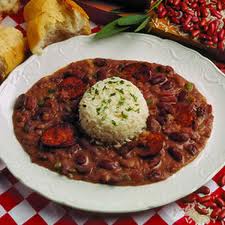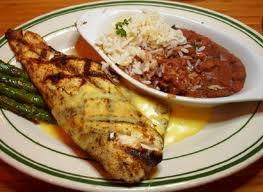New Orleans, a city known for its culture, music, nightlife, and of course… FOOD! Many people know New Orleans as “The Big Easy” since everything there is laid back, simple, and easy-going. But “easy” may be the last thing that comes to your mind when trying to stick with your New Year’s health and sports nutrition resolutions while visiting the Crescent City. Well, here’s a list of 8 nutrition tips and tricks to help keep your goals on track while cheering on our #1 Tigers down in New Orleans.
- Don’t skip breakfast. Better yet, don’t skip any meals! First of all, the food in New Orleans is way too good to pass on a meal. Secondly, and most importantly, skipping meals only leads to overeating once that hunger feeling hits you.
- Plan ahead. Your trip will most likely be a busy one packed with French Quarter tours, fan pep rallies, BCS festivities, Tiger tailgating, and let’s not forget about the big game! Take some time before your arrival to look at your schedule and plan when and where you will eat. Yes, you’re in the Big Easy and may want to take it day by day, but having some sort of plan will prevent you from eating whatever is closest… for example, that Hot Dog from the Lucky Dog stand on Bourbon Street!
- Balance out your day. New Orleans offers so many traditional foods, most of them high in fat, sugar, and calories. Don’t deprive yourself of these “must-try” Creole staples; just be sure to balance out the rest of your day. For example, if you know a big dinner awaits you, plan to eat a lighter breakfast and lunch and vice versa. This way you can stay on track with your goals as well as enjoy the city’s cuisine without any guilt.
- Better your breakfast foods. No doubt, breakfast is the most important meal of the day as it jump-starts your metabolism and gives you energy for the long but fun Downtown day ahead.
• Typical New Orleans breakfast foods include: high fat biscuits and gravy, cheesy grits, and hearty dishes with crab cakes, sausage, eggs, Beignets, and high calorie cheeses and hollandaise sauce.
• Choose one day to eat a healthy portion of these traditional breakfast foods. On the other days, opt for these leaner choices: whole grain toast or English muffins, oatmeal, veggie omelet, eggs or egg whites (spiced with hot sauce and Tony Chachere’s!), turkey sausage, and fresh fruit.
- Lighten your lunch. After walking around in the Quarter all day, you’re definitely going to build-up an appetite. You’re most likely to come across popular lunch foods such as Po-boys, Muffaletta’s, Jambalaya, Gumbo, Etouffee, Red Beans and Rice, and Fried Seafood dishes. Here’s some simple tricks to lighten up these foods:
• Your server may ask if you want your Po-boy “dressed”(this means they’ll add lettuce, tomato, mayo, and possibly other sauces). Instead, opt for a “naked” Po-boy (ask for lettuce and tomato minus the high fat mayo and sauce).
• Go “topless.” Save yourself some calories and carbs by eating your Po-boy or Muffaletta open-faced, without the top portion of bread.
• Instead of French fries or Onion rings, order a side salad (light on the dressing) or steamed seasoned veggies.
• When it comes to fried seafood and chicken dishes such as Po-boys, Platters, and Salads, always opt for the grilled or blackened version. Don’t worry! You won’t miss out on taste. New Orleans cooks are always sure to spice it up just right with lots of Creole seasonings and spices.
• For dishes such as Jambalaya, Gumbo, Etouffee, and Red beans, remember to watch your portions and skip that buttery piece of cornbread.
• Ask the server for a “half portion” of rice with your Gumbo, Etouffee, and Red beans.
- Downsize your Dinner. Dinner time is always a treat as you will be surrounded by many other tourists and locals living it up in the fun New Orleans atmosphere. In addition to the lunch tips, try to utilize these when it’s time to order dinner:
• Read the menu. Be sure to thoroughly look over the restaurant’s menu in order to avoid some “trap food terms.” Trap foods may sound good and healthy, but may end up being the highest fat item! Try to avoid foods containing the words: crispy, crunchy, cheesy, creamy, au gratin, battered, buttery.
• Steer clear of Stuffed. You will often see “Stuffed” foods such as crab, peppers, mushrooms, fish, and more. Keep in mind “Stuffed” consists of buttery and creamy rice, breadcrumbs, and crabmeat… probably not the best choice for your waistline.
• Go for the grilled. Stick with Grilled Fish, Boiled Shrimp, and other Lean Meat dishes with sides such as seasoned steamed vegetables, red beans, greens, or boiled okra.
• Go easy on the Dough. Monitor the amount of bread rolls, cornbread, crab cakes, or other high fat appetizer foods you eat because these calories can add up very quickly.
• Remember portion control! Order a lunch size meal or split it with a friend. You can also pack half the meal in a to-go box and store it in your hotel refrigerator or ice chest to eat the next day.
- Divide some Dessert. You can’t leave New Orleans without having a taste of some of its traditional dessert items: Beignets from Café Du Monde, Bread Pudding, Bananas Foster, Crème Brulee, Pecan Pie, and King Cake. If you order one or two desserts for the table to share, you will automatically avoid eating the entire thing alone.
- Alcohol. New Orleans: The Party Capital of the World! It’s more than likely you will experience the nightlife the city has to offer.
• First off, always remember to be smart and cautious with alcohol. No athlete will benefit from drinking alcoholic beverages, so keep this in mind when you’re down in the Quarter.
• Also, be wary that the most popular French Quarter beverages (Hurricanes, Hand Grenades, and Daiquiris) are full of sugar and extremely high in calories. If you opt for any of these, go for the smallest size or split it with a friend.
• I promise you won’t miss out on any of the fun by choosing one of these lighter beverages: Bloody Mary, Light Beer, Vodka Water with lemon or lime, or Southern Comfort with fresh lime juice.
• Remember that all alcohol calories count and contribute to your daily intake, so be sure to monitor your drinks as well as the late night foods you may come across down in the Quarter.
 ACL Hamstring Tendon Graft Post-Operative Rehabilitation
ACL Hamstring Tendon Graft Post-Operative Rehabilitation








